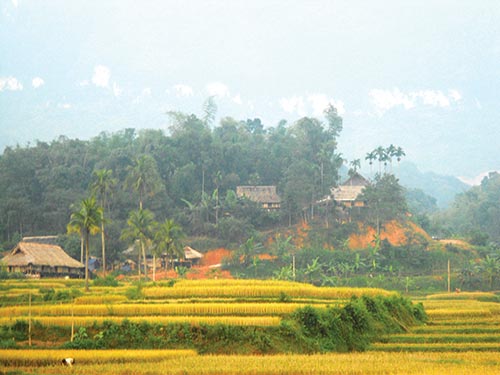
| Thanh Hoa climbs development slope | |
The north-central province of Thanh Hoa consists of 11 mountainous districts, including seven which are poverty-stricken, covering 76 per cent of the province’s total area and home to almost 1.1 million people, or 32 per cent of the province’s population. Deputy head of the Thanh Hoa Provincial Committee of Ethnic Minorities and Mountainous Areas Luong Van Buong spoke with VIR’s Le Dung on the radical improvements the province’s mountainous region has undergone in the past years on the back of concrete government support programmes. What are current advantages and disadvantages of Thanh Hoa mountainous districts? The province benefits from having highland and midland areas, including a northwest mountain range and the Truong Son mountain range and the rugged terrain also provides ideal conditions for hydro-power development. The Chu River and associated estuaries would be ideal for building hydropower plants. Low-lying mountainous and hilly area in the south would suit plantation of cash crops, including eucalyptus, wattle, cinnamon and rubber thanks to fertile soil. Thanh Hoa also boasts mineral resources such as limestone with reserves of 370 million tonnes, chrome ores (22 million tonnes), and alluvial gold, which is found in Cam Thuy, Ba Thuoc and Thuong Xuan areas. Other minerals in the region are clay, iron ores, pumice stone (used in cement production), facing stones and more. This region also features an impressive range of rocky outcrops similar to those found in Halong Bay, creating beautiful caves and imposing natural heritage sites such as Pu Luong karst mountain in Quan Hoa and Ba Thuoc districts, Hai Van in Nhu Thanh district, and famous caves such as Ngoc, Lo Cao in Nhu Thanh district and Ca Than in Cam Luong-Cam Thuy districts. Transport infrastructure has also witnessed remarkable improvements. Route 15A links northern and southern districts. Road 217 leads to Hua Phan province in Laos, and the passage of national highways 47 and 45 link the region to Thanh Hoa city and other plains districts. The legendary Ho Chi Minh Trail is regarded as a backbone, linking localities in the region as well as connecting mountainous districts to other provinces north and south of Thanh Hoa. However despite our advantages, there are problems in Thanh Hoa’s mountainous districts. Firstly, the western districts mainly consist of ethnic minority groups, accounting for about 60 per cent of mountainous region population and they suffer from low culture, which has resulted in on-site labour shortages. Poor households still account for a high 23.6 per cent of all households according to last year’s figures. However, child marriages and marriages between blood relations are still commonplace, representing a challenge to the region’s human development strategy. For instance, from 2009 up to now of 516 married couples in Muong Lat district 55 per cent (or 284 couples) were married as teenagers. In the first half of 2014 alone, 52 out of 73 couples were teenage marriages. How have the government’s ethnic minority support policies been playing out in this region? We’ve benefitted from a raft of incentives to help tap local potential to push socio-economic development thanks to our strategic location. There have been some specific policies to support the region’s development, such as prime ministerial programmes 134 and 135 that target rapid and sustainable poverty reduction, a project to stimulate fixed cultivation and permanent settlement among local people or that promoting rubber plantation by Thanh Hoa authorities. These programmes and projects have generated initial encouraging results. During 2011-2014, these 11 mountainous districts reaped average economic growth rate of 13 per cent per year. Per capita average income grew from VND11.2 million ($530) in 2011 to VND14.1 million ($670) last year. The rate of poor households has reduced by 4.5 per cent per year. Trained labourers have reached 26.6 per cent. By 2013, 92 per cent of communes had paved roads leading to communal centre and 100 per cent of communes had medical stations and doctors. In the first half of 2014 alone, Thanh Hoa mountainous region economy grew 9.4 per cent with 21 licensed investment certificates valued at VND1.537 trillion ($73 million) and 28 business start-ups. What are the mountainous region’s concrete tasks and development solutions in the coming period? Although initial outcomes were seen regarding socio-economic development in Thanh Hoa mountainous region, many things still need to be done for the region to develop sustainably. Accordingly, it is important to continue propagating the government policies on poverty reduction to people in the area, review development plans to ensure it matches local development conditions, revise investment structure for higher efficiency and increase direct transfer of technical progresses to local labourers. The policies on supporting the poor need further appraisals and supplementation and efforts must also concentrate into bettering the quality of vocational training and governance efficiency of local management at different levels. | |
| VIR |
